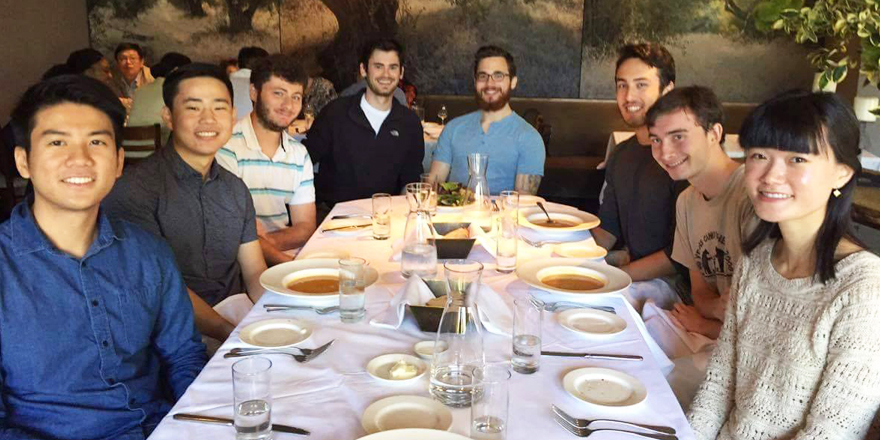Candidates often ask me what it was like to start working at CRA. Some of them worry about being expected to know everything about antitrust law or arrive an expert programmer. CRA does a great job of preparing you for project work no matter your background. Most analysts start at CRA in July and within their first month attend a week-long training in Boston. Since I started in April, months before the formal training, I relied on the Oakland office’s training to prepare me for project work. My onboarding process was also unique because, as a Statistics major, I had little economics experience. However, I learned from Oakland’s trainings and my coworkers. About a week before I started, I received an email from my onboarding buddy Andrew. He introduced himself and made himself available as a resource, in case I had any questions.
My first piece of formal training was the Oakland office’s training binder, which is given to each new hire. The binder contains articles about antitrust and competition, training modules to learn Stata, SAS, and Excel, and other information about the company and office. Working through this binder gave me a solid foundation to begin doing project work. For example, Stata is a commonly used programming language we use at CRA, but I had mainly used Python, R, and Java as an undergrad. The training binder proved to be an excellent reference and my coworkers were incredibly eager to help me. As I learned more about economics and antitrust, senior staff sent me articles to read and discussed them with me. Additionally, my first few months coincided with a training series between the Oakland and Toronto offices where I learned best practices of organization, coding, and more.
 A big part of the onboarding process is the Research and Analysis Core I training (RAC I). All incoming Analysts attend RAC I at the beginning of August, flying from our offices around the world to CRA’s Boston headquarters for a week of intense training. Each day was packed with workshops that trained us on topics such as writing, programming (Stata, SAS, Excel, and VBA), how CRA operates as a business, the analyst experience, and how to maintain your academic connections. One of the best parts was meeting analysts from other offices and practices. During the evenings, all of the new hires participated in fun activities. My favorite activity was bowling on Tuesday. After training ended, I stayed in Boston for the weekend to be a tourist—I even went to a Red Sox game!
A big part of the onboarding process is the Research and Analysis Core I training (RAC I). All incoming Analysts attend RAC I at the beginning of August, flying from our offices around the world to CRA’s Boston headquarters for a week of intense training. Each day was packed with workshops that trained us on topics such as writing, programming (Stata, SAS, Excel, and VBA), how CRA operates as a business, the analyst experience, and how to maintain your academic connections. One of the best parts was meeting analysts from other offices and practices. During the evenings, all of the new hires participated in fun activities. My favorite activity was bowling on Tuesday. After training ended, I stayed in Boston for the weekend to be a tourist—I even went to a Red Sox game!
Throughout the entire onboarding process, my coworkers always made me feel welcome. Whenever I had questions about how CRA operates, I felt comfortable asking my supervisor. I remember when we had lunch together during my first week, I asked her questions about how contracts and billing work, and how CRA gets its cases. From lunches with my mentor, supervisor, and the other junior staff, it seemed like every day offered a new welcoming event including great food. Throughout the week I also had one-on-one meetings with many of the senior staff.
 My favorite part about joining CRA has been the opportunity to learn something new every day. In college, I liked how you could learn about many unique industries through analyzing data. When I was looking for jobs, I was drawn to CRA because I knew I would have the opportunity to use my data analysis skills across different types of industries. In the seven months I’ve been at CRA, I‘ve already worked on 11 projects from industries and institutions in varying sectors, including energy, technology, patents, securities, banks, and credit unions. I have been given leadership opportunities in the form of recruiting and I have improved my personal technical development by attending multiple Tech Labs.
My favorite part about joining CRA has been the opportunity to learn something new every day. In college, I liked how you could learn about many unique industries through analyzing data. When I was looking for jobs, I was drawn to CRA because I knew I would have the opportunity to use my data analysis skills across different types of industries. In the seven months I’ve been at CRA, I‘ve already worked on 11 projects from industries and institutions in varying sectors, including energy, technology, patents, securities, banks, and credit unions. I have been given leadership opportunities in the form of recruiting and I have improved my personal technical development by attending multiple Tech Labs.

